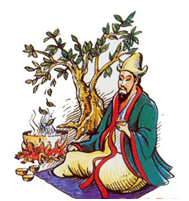Chinese Tea
James Mathew |
One of the great things about being in China for a British person is Chinese tea. After being in China for over three years the great ‘British cuppa’ doesn’t look so great anymore. The famous tea brands regularly consumed back in the U.K. generally come in the form of tea bags. These tea bags usually contain a mix of tea from various places around the world, made in a standardized way for mass consumption. Chinese tea is, fortunately, a lot more fascinating and intricate. To learn about Chinese tea is also a great window into the Chinese way of thinking and culture. Chinese people generally trace the start of their tea culture back a person called Shennong or “God Farmer” of which there are many legends. The legend I’ve heard most frequently, was that when Shennong was sitting under a Camellia tree and boiling some water to drink, leaves suddenly from the tree fell into the water, making the world’s first ever cup of tea. Shennong is also said to have had a transparent body, and could see the great health effects of tea on his own body. Tea is, however, said to have first been eaten and generally used a medicine until the Han Dynasty when it started to be used as a drink.
The tea ceremony that you will see in China today has evolved over many dynasties and encompasses much Chinese thought and philosophy. For example, the movements used in the tea ceremony are based on principles of Daoism and Fengshui. There is something very relaxing about watching a tea ceremony, and even brewing the tea in the traditional way yourself is a great way to unwind. It is believed that every small thing will ultimately influence the taste of tea, from the tea pots that are used and the temperature of the water, to even the frame of mind and personality of the person brewing the tea. My tea teachers, both women, believe that older people and men are generally able to make better tasting tea, as they are more likely to have a calm state of mind.
Apart from learning about the tea ceremony itself, learning about the different kinds of teas is equally fascinating. The tea is generally categorized into green tea, black tea, white tea, yellow tea, red tea and oolong tea, these are then divided up into even more kinds of teas. When buying tea in China, people will normally buy leaves, not tea bags, tea bags are normally made up of leftovers from the tea leaves. These teas will normally be made in a specific location of China and named after the place in which it is made, they often come with a legend as well. For example, one of the most famous teas, Longjing tea comes from the Longjing village near West Lake in Hangzhou and was once a place where the Emperors of China would get their tea.
Ultimately Chinese tea culture is very fascinating, the intricacies of which greatly surpass what can be written here. I very much recommend that if you come to China, you visit your nearest tea culture centre, from my experience Chinese people are always very welcoming and more than happy to teach foreigners about their culture. |














